Hello! My name is Shimada, and I’m a senior in charge of public relations at the University of Tokyo Association Football Club. We have an analysis team called the Technical Staff, and we usually analyze our own team and our opponents. This time, I wanted to let the new students know what the technical staff does, so I asked them to analyze a match of the Japanese national team, which is more familiar to you, instead of the usual analysis. This time, the article was written by Yuta Inoue, a fourth-year member of the technical staff. Please have a look!
It’s a rematch between Japan and Colombia, the two teams that have clashed in two consecutive World Cups, and I’m sure they were highly motivated going into this match, even if it was just a friendly. How well will the new Japan team do against 11-man Colombia? I went to Nissan Stadium with a lot of excitement.
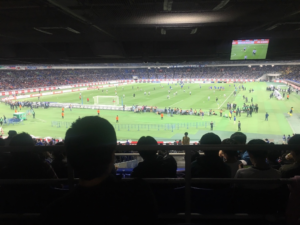
↑I watched the game from behind the goal. It was still a little difficult to see at Nissan Stadium.
In the first half, Japan and Colombia started with the following formation.
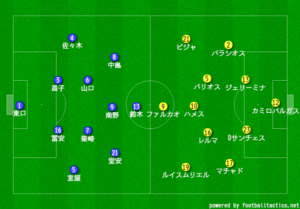
Both teams will play a 4-2-3-1, a formation familiar to the Japanese national team. The players to watch out for are the “new BIG 3” of Nakajima, Minamino, and Doan, as well as right back Muroya and FW Musashi Suzuki, who have been selected to start due to their success in the J-League.
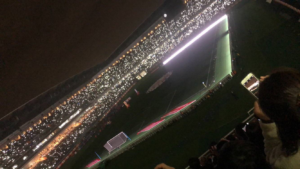
↑The entrance of the players. It was beautiful.
<The first half was a defensive affair. The number of shooting is much higher than the number of control.>
In the first half, Japan set the starting point of their press at the tip of the center circle and waited for Colombia to attack. As Japan’s goalkeeper, Higashiguchi, is not good at building up the ball, Colombia continued to have the ball and Japan defended. On the other hand, Japan took the ball and was able to shoot several times from short counters.
What were the factors that caused this to happen? There were factors in both Japan’s defense and Colombia’s attack, but let’s consider Japan’s defense here. On this day, Japan maintained a compact 4-4-2 formation, and their defense was very good, with the front and back working in tandem. While Japan presses with Suzuki and Minamino up top, Colombia builds up with three backs with the volante dropping down. Suzuki and Minamino eliminated the volante’s course and guided the ball to the side, while the SH also defended by first cutting off the vertical course to prevent the ball from passing into dangerous areas. The next photo shows the scene in the 29th minute of the first half.
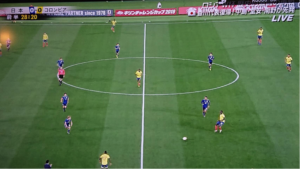
In this scene, the Colombian anchor dropped down and the CBs opened up for the build-up. On the other side of the field, Japan’s Suzuki eliminated the midfield course, and Doan and Shibasaki eliminated the vertical pass course, so the only passing course for Colombia was the SB.

Limiting their options, Japan approached the SB with Doan cutting inside, and at this point, Muroya was ready to come out strong against the opposing SH. At this point, Muroya was ready to come out strong against the SH. He was fouled, but it was a good example of how Japan’s defense was working.
Looking at the attacking side of the game, Japan’s front four players are all good at attacking vertically, and their short counters were quite powerful. As an example, let’s take a look at the scene in the 35th minute of the first half.


In both of these situations, Japan played the same kind of defense as in the previous scene, this time restricting the options to a course to the volley, which was a little late, but allowed Shibasaki to come out strong.

As Shibasaki put pressure on him, the Colombian anchor shifted his agonizing vertical pass, and Tomiyasu, coming on strong, took the ball in front of him. Tomiyasu took the ball in front of him, and despite the fact that there were five players in front of Tomiyasu, the volante tried to jump in. He got past him, and Japan launched a quick counter.

Japan countered and eventually succeeded in creating a 2v1 on the right side of the field, which allowed Shibasaki to cross from a good position.
It was a good first half for Japan, but both teams failed to score and the game ended 0-0. This was backed up by the fact that Japan was able to shoot three times as many shots (9 vs. 3), despite having a much lower percentage of ball control (36% vs. 64%). However, the fact that most of the shots were mid-range shots and the lack of decision-making ability, which is said to be the “eternal problem,” was exposed in this game as well.
<Colombia corrects, pushes back, and loses a goal>
After a first half in which key players Hamels and Falcao struggled to make a mark, Colombia made changes at halftime. First of all, eight minutes into the second half, Hames came down the flank of the CB to disrupt the Japanese defense.

In this scene, you can see that Hames is falling to the side of the CB. This pushes Machado, the left back, higher and Muriel, the left SH, inside. Unable to cope with this shift, Japan’s midfield line was breached.

Shortly after, Machado passes a floating ball to Falcao. At this point, you can see that Japan’s left SH, Nakajima, has not returned. Nakajima’s defense was one of Japan’s weak points, but Colombia was aiming for it.

The space left by Nakajima was filled by Yamaguchi, but he could not get there in time to get a good cross in. The goal was ruled out due to a hand, but it could have been a goal.
In the 12th minute of the second half, Colombia made a change of players. In the 12th minute of the second half, Colombia made a substitution, replacing Villa with Zapata and switching to a two-goal advantage with Hamels on the right side. This allowed Hamels, who had been unable to receive the ball effectively in Japan’s defensive block, to receive the ball more positively on the side, and with more targets, Falcao began to drop and keep the ball more often.

In this scene, Hamels has the ball forward on the right side. It is Nakajima who responds. With the advantage, Hamels cuts in and creates a vertical path for a pass.
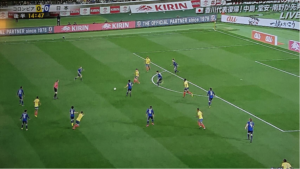
The cut-in disrupted Japan’s formation and led to a vertical pass to Falcao. Thus, the change of tactics allowed Colombia to catch the flow of the game.
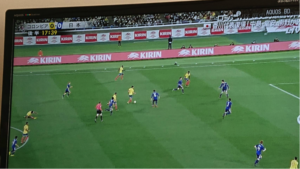
This is the scene just before the goal was scored, and you can see that Falcao is able to play forward on the flank of the volley because Zapata is creating depth at the back left. Thus, it was a delicate decision, but the penalty kick was taken and the goal was scored.
<The team changes players to get the flow going again, but loses the game without scoring.>
After scoring a goal, Japan was unable to build an attack, and Colombia continued to control the pace of the game, mainly through counters. That’s when Coach Moriyasu made his move. Kagawa replaced Suzuki, and six minutes later, Inui and Kobayashi were introduced in place of Doan and Yamaguchi. From this point on, Japan had the upper hand in the buildup, with Shibasaki dropping to the defense line and Kagawa receiving the ball between the lines.
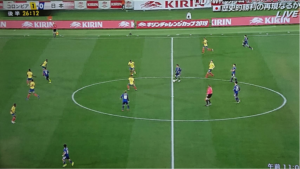
Kagawa receives the ball on the flank of the anchor. By directing the opposition’s attention to the center of the field, Nakajima, who is stretched outward, comes into play.

In this scene, Nakajima cut in and the CB was fished out, and Kagawa went for the space. The trap went awry and it didn’t lead to a chance, but it was a scene that showed potential.
However, it was not enough to break down the Colombian defense, and the game ended 0-1.
<Game Summary>
Throughout the match, I personally think that there were many improvements in both offense and defense compared to the Asian Cup, and that it was a good performance. Nakashima showed an outstanding performance in dribbling and making chances, Suzuki showed his characteristics in his ability to keep possession and cross, and Tomiyasu fully demonstrated his stability and strength. However, we were not able to respond well to Colombia’s change of strategy in the second half and lost a goal, so we still have a lot of work to do in terms of our ability to correct ourselves during the game. I have high hopes for the future of the Japanese national team.
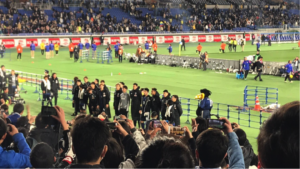
↑After the game. Let’s hope for the future.
<Finally>
Thank you for reading to the end. And to all the new students, congratulations on your enrollment. The technical staff works hard every day to lead the team to victory by analyzing the game. If you are not confident in your ability to play but love soccer or love to watch soccer, we would like you to join our club. If you have any interest, please feel free to come and see us. Thank you for your continued support of the University of Tokyo’s soccer club!
Yuta Inoue, Technical Staff, A-Shiki Kickball Club
